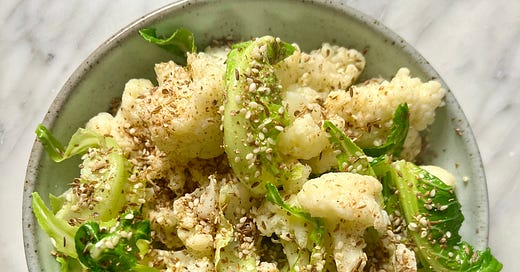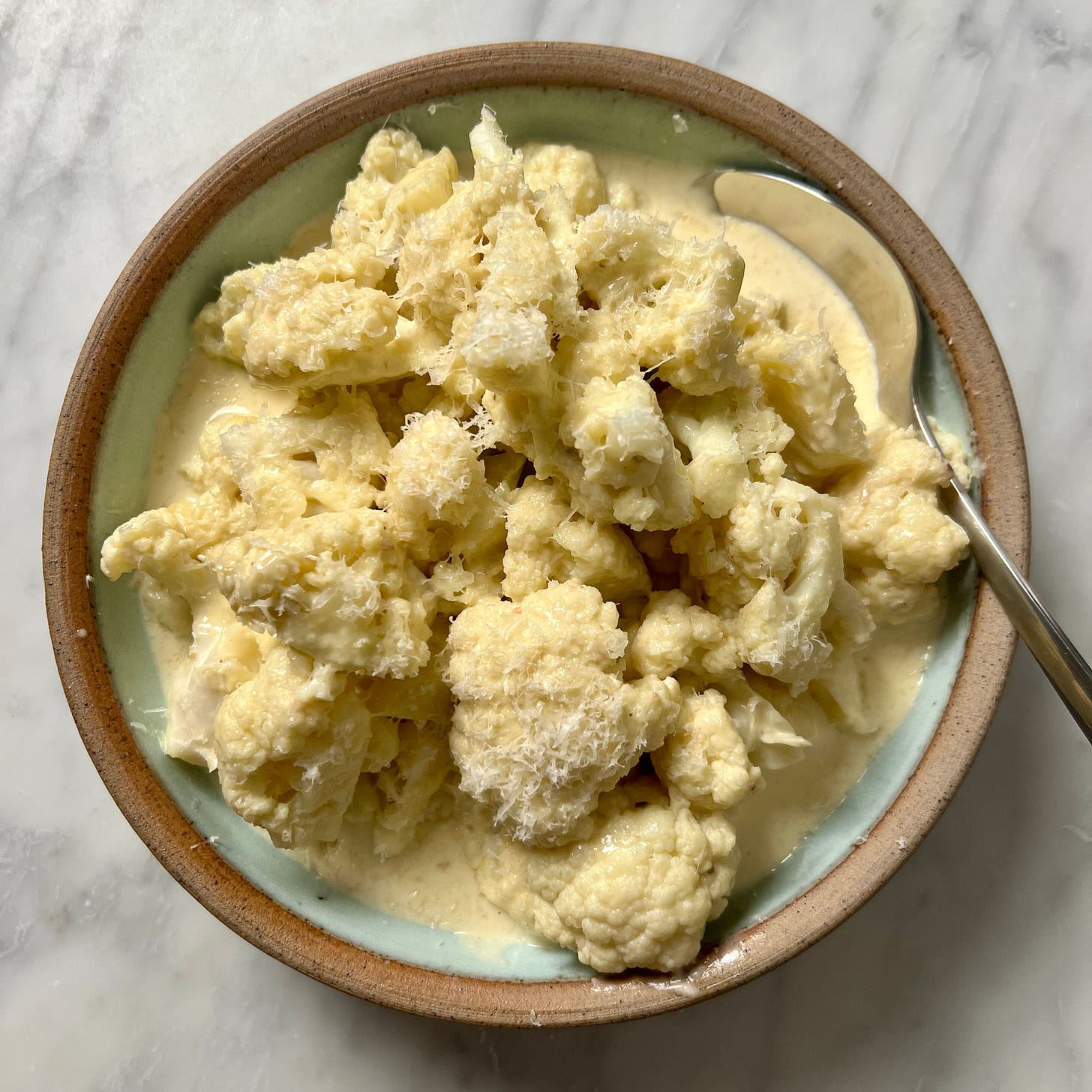Some of you will know my first cookbook, On the Side. As the title suggests, it’s a book about side dishes … but good ones: sides to build a meal around; or to perfectly match a centrepiece; or to change the tone and style of the meal. Sides can do that. They’re important.
It was published in 2017, and mostly written two years before that. But people still tell me they think it’s one of the most used books on their cookshelf. Which is always cheering to hear and, actually (#humblebrag), I agree: it’s good! Frankly, if it had sold more I would have loved (would still love…) the opportunity to write a follow-up (Second Helpings On the Side? A Little Extra On the Side?).
In the absence of that project / in the meantime, I thought I’d reignite the theme here as a monthly column.
Each edition will focus on one vegetable, grain or pulse. There’ll be a bit of chatter about what the ingredient tends to go well with and alongside, plus a few broad brush (but useful) comments about cooking methods. And then I’ll offer three recipes: a quick embellishment; a simple twist; and a side to spark an entire meal. Depending on my mood and the prevailing wind, a portion or all of the recipe element of these posts will be for paid subscribers. You can easily become one…
(Small monthly/annual fee —> recipes, words, Oxford commas, and my eternal love.)
First up: cauliflower
Not everyone’s favourite vegetable.
In fact, I suspect quite a few people think that they actively dislike the humble chou-fleur. While more positive murmurings might include: “a bit bland” and “boring”.
But that is all the more reason to take a deep dive, and to suggest ways to make it more exciting. So let’s do that.
Cauliflower goes especially well with
Depends on the preparation (whether plain; lightly seasoned; puréed; roast; or creamy), but as a general rule it’s a relatively unassuming vegetable that rarely clashes with other flavours. Indeed it is an excellent, low-key partner for central components (or other sides) that are very rich, very cheesy, confidently spiced, or tomatoey.
Beef — any roasting joint; rib-eye steaks; luscious, ground beef dishes (particularly if curried or tomato-based; a juicy brisket, intense ragu, or other low and slow dish.
Chicken — roast chicken; a stew or braise involving thighs and/or drumsticks; breaded chicken such as kyiv, schnitzel, parmigiana.
Pork — salty/smoky cuts such as bacon, gammon steaks, large cooked ham on the bone, ham hock; slow-cooked pork shoulder; a fatty pork chop.
Lamb — slow roast shoulder, leg or breast; fatty chops.
White fish — particularly cod or other flaky white fish where there is also a creamy, spiced or tomato-based sauce.
Shell fish — loves a scallop, particularly when puréed (the cauliflower).
Serve alongside
As mentioned, cauliflower has a relatively gentle, accommodating flavour that rarely clashes with others. It’s about ensuring other sides bring either a punchy flavour, some bite or crunch, or some starch and heft.
There needs to be something green nearby — peas, green beans, leeks, a leafy brassica or its own greens (see below).
Potato is surely the best carb when cauliflower is involved … with Boulangere-style (if the cauliflower is creamy) or Dauphinoise (if it is not) high up the list.
Rice, grains, lentils, beans all match neatly too.
Also consider whether pliable flatbreads would suit the meal — cauliflower is good when scooped-up and squidged.
Useful condiments and seasonings
Dress your cauliflower. It’s quite dull otherwise.
Drizzles: extra virgin olive oil; cold-pressed rapeseed oil; sesame oil; tahini; yoghurt; lemon juice; chimichurri; zhug; oyster sauce; soy sauce; chilli oils.
Sprinkles: flaky salt; black pepper; white pepper; Parmesan; nutmeg; za’atar; dukkah; sesame seeds; chilli flakes; paprika; cumin; turmeric; curry leaves; pomegranate seeds; dried fruits such as dates, sultanas, cranberries and sour cherries.
How to cook cauliflower
Cook everything. Including the greens (these can be saved for another day if you prefer). The thickest leaves/ribs should be chopped and blanched for a couple of minutes. The leaves that are closest to the crown are delicate and don’t really need any cooking at all, while the next two or three layers need only 30-60 seconds of blanching, or even just residual heat.
Break the cauliflower into florets — I tend to pull or cut fairly close to the base of each floret so then end up as lots of near bite-size nubbins (see in the video below). If you prefer bigger florets, that’s fine too. The most important thing is that each of your pieces are broadly the same size.
Personally I prefer steaming over boiling, but either method is fine. Cook until tender but toothsome. Once soft the vegetable can become a little mushy, watery and pointless (best case), or even grey and sulphurous (my guess is that’s where it’s not-always-top reputation comes from). Timing depends on the size of florets, but steamed takes 7-10 minutes, blanched 4-5 minutes (dropped into already boiling and heavily salted water). I’ll repeat: aim for tender but toothsome.
Roasted cauliflower is excellent. Weirdly, very few recipes provides the correct cooking time, often suggesting you can achieve satisfyingly roast cauliflower in around 30 minutes. Nope. IMHO this vegetable needs 45-60 minutes (at 180-200C fan), because for much of that time the florets will simply be releasing steam (there’s a high water content), and that means whatever the temperature of the oven, the temperature immediately around the cauliflower will be around 101C. Ain’t no bronzing or browning happening while that is the case. As with all roast vegetables, ensure the florets have enough space around them, otherwise they’ll just bake (use two trays if necessary). Also, portion-wise, you tend to need around twice as much cauliflower when roasting, as (again) so much of its mass is water, and that disappears into the hot air.
Cauliflower makes a top puree. And a little goes a long way. Use a small saucepan and cover the cauliflower with just enough milk. Use that milk when blending into a smooth and silky purée. There’s a recipe for yeasted cauliflower purée in On the Side….
Riced? Nah…
Although, on a related uncooked and finely chopped theme: cauliflower is good raw. And I’ll admit that a small amount blitzed (effectively ‘riced’) in a food processor is actually fine to include as a niblet within, say, a couscous, bean, pearly barley or lentil salad. I also really like cauliflower when it’s been shaved with a mandoline, lightly salted and tossed in olive oil and lemon juice, or a moscatel vinegar. Could be part of a slaw or shaved salad involving kohlrabi, celeriac, white cabbage, apple … that sort of thing.
Recipes
Cauliflower with lemon vinaigrette and dusty spices.
Creamed cauliflower. (The classic cauliflower cheese sits in the middle of a Venn diagram comprising circles labelled ‘too much of a faff’; ‘potentially disappointing’; and ‘is actually a main’. But if you like creamy, cheesy cauliflower (and you should), this is an alternative that takes a fraction of the time and effort).
Roast cauliflower, Medjool date and lentil salad. Pretty easy to put together, and the kind of side that you can build a meal (or a feast) around. Rich, intense stews, slow roast lamb or beef; whole baked or grilled fish. It’s a good’n.
The quick embellishment
Cauliflower with lemon vinaigrette and dusty spices
Go big on the sprinkle. Which is more than a scattering of a single spice (something like nutmeg is good in that scenario), but also one nut short of a traditional dukkah. To me that’s right — I’m after a dusty hit of flavour rather than crunch (you could swap the home-made mix with za’atar) — although feel free to add hazelnut, cashew, pistachio etc and enjoy their texture and savoury tones, should you fancy that or your meal require it.
Crucially, as well as the spice, there’s a simple lemon dressing, which perks up the cauliflower no end, and ensures this is a bright and interesting side, ideal next to something fatty (slow cooked lamb shoulder or fatty lamb or pork chops, perhaps), or crunchy, such as a chicken schnitzel or Kyiv.
Serves 4
1/2 tbsp cumin seeds
1/2 tbsp coriander seeds
1 tsp toasted sesame seeds
1/2 tsp flaky sea salt
1 x 400-500g cauliflower cut into florets and greens
3 tbsp extra virgin olive oil
Juice of 1/2 lemon
1/3 tsp caster sugar
Lightly toast the spices in a dry pan until fragrant. Use a pestle and mortar to bash them close to but not quite a powder (so the seeds are split open and less likely to stick between teeth). Combine with the sesame seeds and flaky salt and set to one side / transfer to a little airtight pot until required.
Steam or boil the cauliflower florets until tender but toothsome, adding greens to the pan or steaming basket 1-2 minutes before the white parts are done.
Meanwhile, in the base of a medium-sized mixing bowl, whisk together the olive oil, lemon juice and sugar.
Drain and transfer the cauliflower and greens into the mixing bowl. Gently toss and mix the contents until well dressed, then transfer to a shallow bowl or platter (on which the cauliflower sits 1-2 pieces deep). Scatter the spice mix very generously over the top. Serve immediately (although it’s not bad at room temperature as a buffet-style side).
The simple twist
Creamed cauliflower
I think this is my favourite of the three recipes.







